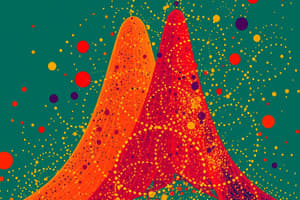Podcast
Questions and Answers
What is the value of the random variable X when two coins are tossed and one tail appears?
What is the value of the random variable X when two coins are tossed and one tail appears?
- 3
- 2
- 1 (correct)
- 0
How many total possible outcomes are there when tossing two coins?
How many total possible outcomes are there when tossing two coins?
- 6
- 4
- 8 (correct)
- 2
If the random variable Z represents the outcome of a single die roll, what values can Z take?
If the random variable Z represents the outcome of a single die roll, what values can Z take?
- 1 to 12
- 1 to 6 (correct)
- -1 to 6
- 0 to 6
What is the probability of rolling a 3 with a fair six-sided die?
What is the probability of rolling a 3 with a fair six-sided die?
When tossing three coins, what possible maximum value can the random variable X reach?
When tossing three coins, what possible maximum value can the random variable X reach?
If the outcomes of a coin toss are represented as Heads (H) and Tails (T), how would the outcome 'HTH' be interpreted in terms of tails?
If the outcomes of a coin toss are represented as Heads (H) and Tails (T), how would the outcome 'HTH' be interpreted in terms of tails?
Which of the following statements about the sum of probabilities is true?
Which of the following statements about the sum of probabilities is true?
When analyzing the outcomes of tossing two coins, which scenario describes an event with more than one tail?
When analyzing the outcomes of tossing two coins, which scenario describes an event with more than one tail?
What is the primary focus of statistics as described in the content?
What is the primary focus of statistics as described in the content?
How is probability expressed according to the content?
How is probability expressed according to the content?
Which letter represents a random variable that denotes the number of defective bulbs in a sample?
Which letter represents a random variable that denotes the number of defective bulbs in a sample?
What does a random variable map in a statistical experiment?
What does a random variable map in a statistical experiment?
Which of the following is classified as a discrete random variable?
Which of the following is classified as a discrete random variable?
Which is a characteristic of a continuous random variable?
Which is a characteristic of a continuous random variable?
What does the letter Y represent in the context of random variables?
What does the letter Y represent in the context of random variables?
According to the definitions provided, how does Sir Arthur Lyon Bowley define statistics?
According to the definitions provided, how does Sir Arthur Lyon Bowley define statistics?
Which of the following represents a discrete random variable?
Which of the following represents a discrete random variable?
Which example accurately characterizes a continuous random variable?
Which example accurately characterizes a continuous random variable?
What is true about discrete random variables?
What is true about discrete random variables?
In the context of variables, which option signifies an uncountable infinite set of possible values?
In the context of variables, which option signifies an uncountable infinite set of possible values?
Identify the option that is a discrete random variable from the following:
Identify the option that is a discrete random variable from the following:
Which of these represents a valid classification of a random variable?
Which of these represents a valid classification of a random variable?
Which of the following is not an example of a continuous random variable?
Which of the following is not an example of a continuous random variable?
What describes the possible values of a discrete random variable?
What describes the possible values of a discrete random variable?
Flashcards are hidden until you start studying
Study Notes
Statistics
- Statistics is the study of data collection, analysis, interpretation, presentation, and organization.
- Statistics can be described as a mathematical discipline for summarizing and collecting data.
Probability
- Probability signifies possibility, a branch of mathematics focusing on the occurrence of random events.
- Probability values range from zero to one.
- Probability is introduced in mathematics to predict the likelihood of events.
Random Variables
- A random variable refers to a set of possible values derived from a random experiment.
- It can be viewed as a mapping of the outcomes of statistical experiments determined by chance into numerical values.
- A random variable is commonly denoted by a capital letter, usually X.
- The value of a random variable can be either numerical or categorical.
Types of Random Variables
- Discrete: Can only take on a finite number of distinct values. Usually whole numbers.
- Continuous: Can take on an infinite number of values within a given range. Measurable quantities with very small changes.
Examples of Discrete and Continuous Variables
- Discrete: The number of eggs in a basket, the number of votes in an election, the number of diaper changes in a day.
- Continuous: Water temperature, the distance leaped by a long jumper, the length of time an airplane flight is delayed, the speed of the wind.
Possible Values of a Random Variable
- Values obtained from functions assign a real number to each point in a sample space.
- Example: If a basketball team plays three consecutive games, the sample space includes all possible outcomes:
- WWW, WWL, WLW, WLL, LWW, LWL, LLW, LLL
- These outcomes can be assigned numeric values: {1, 2, 3, 4, 5, 6, 7, 8}
Probability of a Value
- The probability of a particular value of a random variable can be represented as P(X = value) = probability of that value.
- Example: If a die is thrown once, X = {1, 2, 3, 4, 5, 6}. Each outcome has an equal probability of 1/6.
- P(X = 1) = 1/6
- P(X = 2) = 1/6
- ... and so on.
- The sum of all probabilities for all possible values should always be 1.
Studying That Suits You
Use AI to generate personalized quizzes and flashcards to suit your learning preferences.




